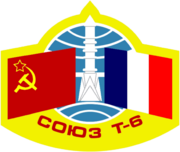| COSPAR ID | 1982-063A |
|---|---|
| SATCAT no. | 13292 |
| Mission duration | 7 days, 21 hours, 50 minutes, 52 seconds |
| Orbits completed | 125 |
| Spacecraft properties | |
| Spacecraft type | Soyuz-T |
| Manufacturer | NPO Energia |
| Launch mass | 6,850 kilograms (15,100 lb) |
| Crew | |
| Crew size | 3 |
| Members | Vladimir Dzhanibekov Aleksandr Ivanchenkov Jean-Loup Chrétien |
| Callsign | Pamir (Pamirs) |
| Start of mission | |
| Launch date | 24 June 1982, 16:29:48 UTC |
| Rocket | Soyuz-U |
| Launch site | Baikonur 1/5 |
| End of mission | |
| Landing date | 2 July 1982, 14:20:40 UTC |
| Landing site | 65 kilometres (40 mi) NE of Arkalyk |
| Orbital parameters | |
| Reference system | Geocentric |
| Regime | Low Earth |
| Perigee altitude | 189 kilometres (117 mi) |
| Apogee altitude | 233 kilometres (145 mi) |
| Inclination | 51.7 degrees |
| Period | 88.7 minutes |
| Docking with Salyut 7 | |

Soyuz programme (Crewed missions) | |
Soyuz T-6 was a human spaceflight to Earth orbit to the Salyut 7 space station in 1982.[1] Along with two Soviet cosmonauts, the crew included a Frenchman, Jean-Loup Chrétien.[1]
The Soyuz-T spacecraft arrived at Salyut 7 following launch on 24 June 1982 and one day of solo operations. During the T-6 mission's time docked to the station, the crew performed joint Soviet-French experiments, including cardiovascular echography, alongside the station's resident crew.[2]
- ^ a b "Mir Hardware Heritage" (PDF). National Aeronautics and Space Administration. Archived from the original (PDF) on 7 September 2009. Retrieved 8 October 2011.
- ^ "Human Spaceflights: International Flight-No. 82". Spacefacts.de. Retrieved 8 October 2011.